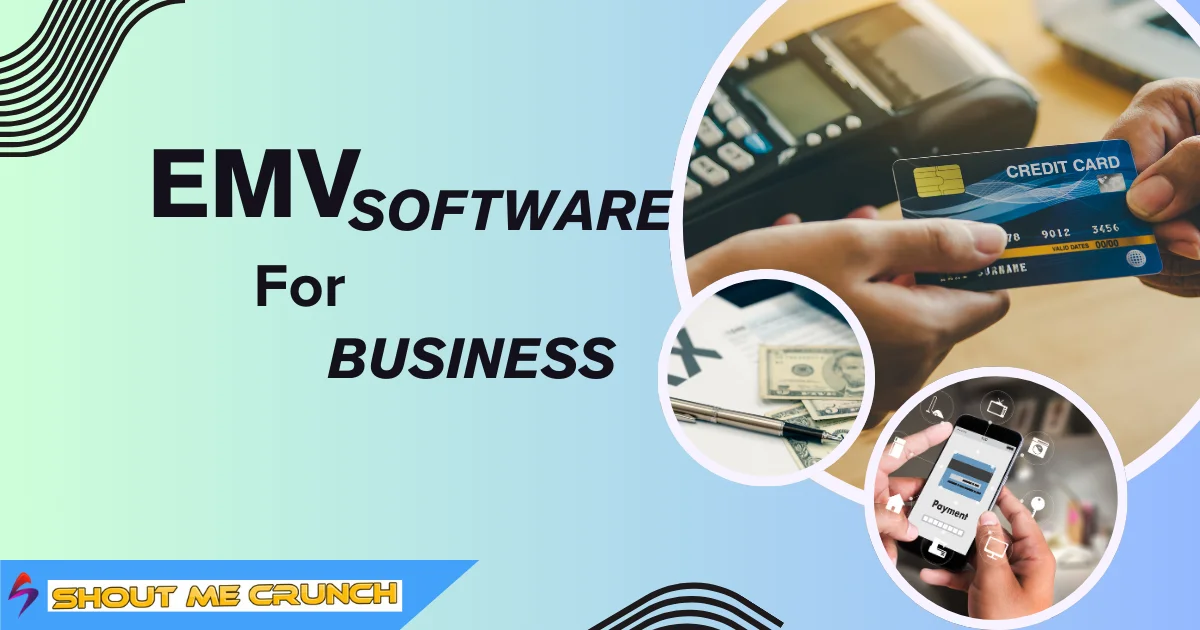EMV (Europay, Mastercard, and Visa) chip technology is now the global standard for secure credit card transactions. It is the most important for the transaction system. While it significantly benefits fraud reduction, organizations’ shift to EMV compliance was not without hurdles. This article discusses the challenges businesses encountered throughout the EMV adoption process. Let’s examine the software.
what is EMV software?
EMV software refers to the programs and systems that enable secure transactions with EMV chip-based cards. Using a card makes it easy to transition anytime. This software is crucial for securing chip-based credit card transactions. Its main functionalities include:
- Data Encryption: It protects critical card information during transactions by encrypting it, rendering it unreadable to potential attackers. In that way, EMV preserves the money.
- Card and Reader Authentication: The EMV chip on the card and the payment terminal are rigorously verified to confirm their legality and prevent illegal transactions. The chip easily catches the illegal receiver.
- Unique Transaction Codes: Each purchase creates a one-time code to prevent unauthorized duplication of card information.
- Dynamic Data Exchange: The card and the issuing bank communicate in real time to perform additional security checks, strengthening the transaction process. Real document submission is the most important part of this.
What is the use of EMV software?
EMV software is critical in ensuring the security of financial transactions conducted with EMV chip cards. People can quickly cash out using a unique and specific card. It is a secure link between the chip on the card, the payment terminal, and the issuing bank. This software manages several vital functions:
- Enhanced Security: EMV software encrypts sensitive card data, rendering it unreadable to potential attackers and dramatically lowering the chance of data breaches. Every person has a unique chip card to continue their transition system.
- Fraud Prevention: It authenticates both the card and the payment terminal, preventing the use of counterfeit cards or compromised terminals. You also have a unique PIN code that is more powerful for your security.
- Unique Transaction Codes: Each purchase generates a one-time code, preventing fraudulent duplication of card information.
- Real-time Communication: EMV software allows for real-time communication between the card and the issuing bank, which adds security to the transaction process. They provide live customer service to check your validity.

By applying these security features, EMV software dramatically minimizes the danger of credit card fraud, shielding consumers and companies from financial damages. Thus, the EMV software works in a transition system.
Business Tips: Boost Your Business with EMV Software
The Cost Factor
Upgrades to Custom EMV-enabled point-of-sale (POS) terminals were costly for many firms and tiny and medium-sized enterprises (SMEs). For business development, it is the most helpful choice. The initial cost of new technology and software may be prohibitively expensive, delaying adoption. Some businesses, particularly those with low transaction volumes, may have questioned their return on investment. There are some limitations to this if anyone chooses this business process.
The Time Crunch
The deadlines for EMV compliance loomed large, forcing firms to modify their systems and train their employees. It gives flexibility for transactions from anywhere. Smaller enterprises with fewer resources frequently struggled to meet these deadlines, incurring penalties for fraudulent transactions. That protects your security.
The Learning Curve
Integrating EMV technology with existing payment systems could be a complex process. Businesses had to learn new procedures for handling chip card transactions, including PIN verification and handling potential chip card errors. Staff training became crucial to ensure a smooth transition and minimize customer inconvenience.
The Education Gap
The initial rollout of EMV technology coincided with a period of customer education. Many consumers were unfamiliar with chip cards and the new transaction process. Businesses had the additional responsibility of educating their customers about using chip cards and PIN verification, potentially leading to slower checkout times during the initial phase.
EMV’s Limitations
While EMV significantly reduces counterfeit card fraud, it doesn’t eliminate it entirely. Other types of fraud, like online scams or stolen card information used for card-not-present transactions, remained a concern. Businesses needed to implement additional security measures to address these vulnerabilities.
Beyond the Struggles
Despite the challenges, EMV adoption has brought significant benefits to businesses. The most significant gain is the transfer of liability for fraudulent transactions. Most of the time, it is free from fraud. EMV-compliant businesses are often not held accountable for counterfeit card fraud, which provides financial security. Furthermore, EMV technology increases customer trust and confidence in the security of their transactions, which may lead to increased sales. It also secures your money by giving you a passcode.

The Road Ahead
The EMV landscape is constantly evolving. Technologies are being updated. New rules and regulations are continually being developed to combat emerging security dangers. Businesses must be aware of this and change their processes properly. Furthermore, the proliferation of contactless payment methods, such as tap-and-pay, necessitates additional infrastructure changes. It will grow your business and secure the transition system.
What is the penalty for EMV?
While there are no legal penalties for not using EMV technology, the repercussions of noncompliance are severe. Here’s why.
Liability Shift:
Businesses that process transactions using non-EMV techniques, such as magnetic stripe cards, are liable for fraudulent charges. It may take extra charge. This implies they carry the financial burden instead of the issuing bank, potentially resulting in significant losses.
Merchant Service costs:
Payment processors frequently charge additional fees for non-EMV-compliant firms. For each card, you have to pay an extra charge every month. These costs might be paid monthly, annually, or at a set amount, which affects the bottom line.
PCI investigations:
In cases of fraud caused by noncompliance, credit card issuers may begin investigations, potentially resulting in hefty fines and additional costs associated with the investigative process. That creates harassment for the user.
As a result, while not strictly a legal punishment, the financial consequences of noncompliance are severe, making EMV implementation critical for businesses to protect themselves and prevent substantial economic losses. So, you must be careful when using the card in EMV software.
Can EMV chips be tracked?
No, EMV chips do not include built-in tracking features. They are not GPS gadgets and cannot send your physical position. There is no tracking chip in this card. It is safe to use. Their primary duty is storing and handling credit card information securely.
Here’s why EMV chips cannot be tracked:
Focus on Security:
EMV chips are designed for better security rather than location tracking. It takes work to track. In contrast to magnetic stripes, which are easily replicated, they use advanced encryption and authentication processes to protect critical information.

No GPS Functionality:
EMV chips lack the hardware and software required for GPS tracking. This highly technological card is used only for transition. They merely store and process data in a secure semiconductor environment.
While EMV chips cannot be directly traced, it is critical to be aware of potential risks.
Skimming Devices:
Malicious actors may use skimming devices at compromised terminals to collect card information during transactions. However, this does not entail tracking the card’s position, but rather duplicating its data for fraud.
Transaction Data Monitoring:
While card issuers and retailers do not directly track your location, they may analyze transaction data to avoid fraud. This research focuses on detecting unusual spending trends rather than determining your physical location.
As a result, while EMV chips provide essential security benefits, it is critical to remain watchful against potential skimming efforts and aware of how transaction data may be used for legitimate purposes such as fraud prevention.
Conclusion
The EMV implementation process provides excellent learning opportunities for enterprises. It emphasizes the significance of thorough planning, funding, and employee training while integrating new technologies. The EMV software business idea is fantastic. Furthermore, excellent customer communication is critical to ensure a seamless changeover. As technology advances, firms that take a proactive approach to security will be better positioned to prosper in the ever-changing payments industry. It is an excellent choice if you want to build up a business in the modern world.


